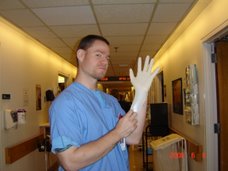
http://www.nursingworld.org/ojin/topic14/tpc14_4.htm
With predictions that this nursing shortage will be more severe and have a longer duration than has been previously experienced, traditional strategies implemented by employers will have limited success. The aging nursing workforce, low unemployment, and the global nature of this shortage compound the usual factors that contribute to nursing shortages. For sustained change and assurance of an adequate supply of nurses, solutions must be developed in several areas: education, healthcare deliver systems, policy and regulations, and image. This shortage is not solely nursing's issue and requires a collaborative effort among nursing leaders in practice and education, health care executives, government, and the media. This paper poses several ideas of solutions, some already underway in the United States, as a catalyst for readers to initiate local programs.
Key words: nursing shortage, solutions
The Nursing Shortage: Solutions for the Short and Long Term
Every article, speech and interview about the nursing shortage notes that it is a different type of shortage than in the past. Some contributing factors remain the same, such as women having more choices for a career. Key differentiators from the previous two shortages are the aging of nurses, the general workforce shortages in ancillary professions and support labor, and the global nature of this shortage. In addition, the fundamental changes in how patients are cared for in a managed care environment is compounding the shortage. With decreased length of hospital stays and more acute care in the ambulatory and home settings, the need for experienced, highly skilled nurses is unmet. A numerical analysis may indicate enough current numbers, but the level of expertise may be the cause of the problem.
From an economic perspective, this shortage is being driven more by the supply side of the supply/demand equation than the demand side. Thus, this is a more complex shortage, which promises to worsen during the next decade as more nurses retire. Past economic solutions such as sign-on bonuses, relocation coverage, or new premium packages will have limited and temporary effect because they simply redistribute the supply of nurses, not increase it.
Past economic solutions such as sign-on bonuses, relocation coverage, or new premium packages will have limited and temporary effect because they simply redistribute the supply of nurses, not increase it.
However, these solutions are already gaining in popularity again as evidenced by ads in local newspapers. The solutions to create a sustained improvement to the nursing shortage will need to be more radical than past shortages and must address many long-term issues.
In addition to the worsening nurse shortage is the shortage of other staff including various allied health professionals, secretaries, and support staff. The shortages of other staff are adversely impacting nurses who have the most continuous and closest relationship with patients and their families. In the early 90's, for cost cutting reasons, there was an increased use of unlicensed assistive personnel. However, these models have failed due to increasing patient acuities, the concerns over medical errors, and the declining numbers of ancillary personnel.
With predictions that this nursing shortage will be more severe and have a longer duration than has been previously experienced, traditional strategies implemented by employers will have limited success. The aging nursing workforce, low unemployment, and the global nature of this shortage compound the usual factors that contribute to nursing shortages. For sustained change and assurance of an adequate supply of nurses, solutions must be developed in several areas: education, healthcare deliver systems, policy and regulations, and image. This shortage is not solely nursing's issue and requires a collaborative effort among nursing leaders in practice and education, health care executives, government, and the media. This paper poses several ideas of solutions, some already underway in the United States, as a catalyst for readers to initiate local programs.
Key words: nursing shortage, solutions
The Nursing Shortage: Solutions for the Short and Long Term
Every article, speech and interview about the nursing shortage notes that it is a different type of shortage than in the past. Some contributing factors remain the same, such as women having more choices for a career. Key differentiators from the previous two shortages are the aging of nurses, the general workforce shortages in ancillary professions and support labor, and the global nature of this shortage. In addition, the fundamental changes in how patients are cared for in a managed care environment is compounding the shortage. With decreased length of hospital stays and more acute care in the ambulatory and home settings, the need for experienced, highly skilled nurses is unmet. A numerical analysis may indicate enough current numbers, but the level of expertise may be the cause of the problem.
From an economic perspective, this shortage is being driven more by the supply side of the supply/demand equation than the demand side. Thus, this is a more complex shortage, which promises to worsen during the next decade as more nurses retire. Past economic solutions such as sign-on bonuses, relocation coverage, or new premium packages will have limited and temporary effect because they simply redistribute the supply of nurses, not increase it.
Past economic solutions such as sign-on bonuses, relocation coverage, or new premium packages will have limited and temporary effect because they simply redistribute the supply of nurses, not increase it.
However, these solutions are already gaining in popularity again as evidenced by ads in local newspapers. The solutions to create a sustained improvement to the nursing shortage will need to be more radical than past shortages and must address many long-term issues.
In addition to the worsening nurse shortage is the shortage of other staff including various allied health professionals, secretaries, and support staff. The shortages of other staff are adversely impacting nurses who have the most continuous and closest relationship with patients and their families. In the early 90's, for cost cutting reasons, there was an increased use of unlicensed assistive personnel. However, these models have failed due to increasing patient acuities, the concerns over medical errors, and the declining numbers of ancillary personnel.




1 comment:
I know professionals in the industry are taking a serious look at the current and future supply and demand of the field... Rightfully so! Too often we don’t know what we have until it is gone and needed...so, thank you for spotlighting the issue even more.
Post a Comment